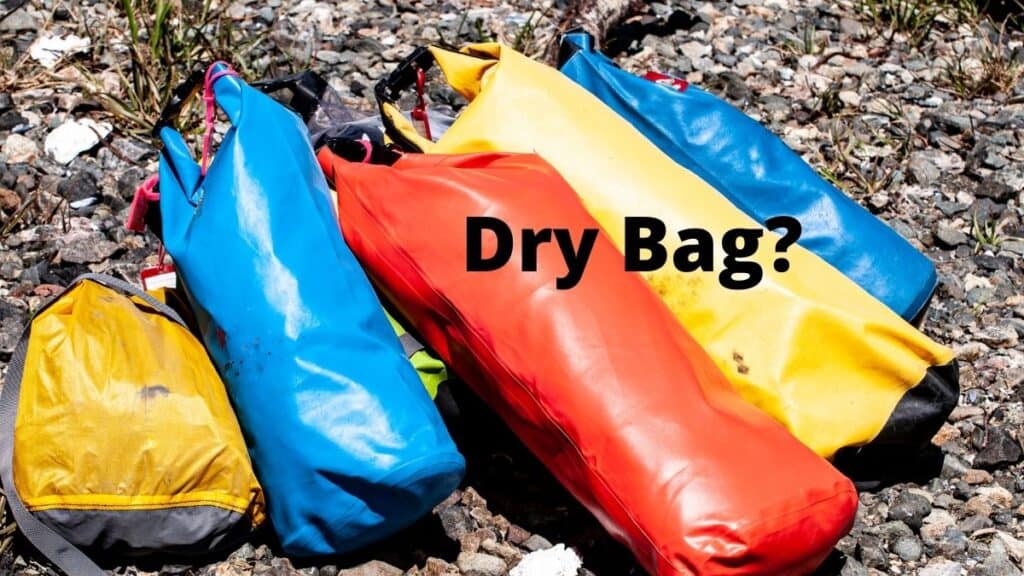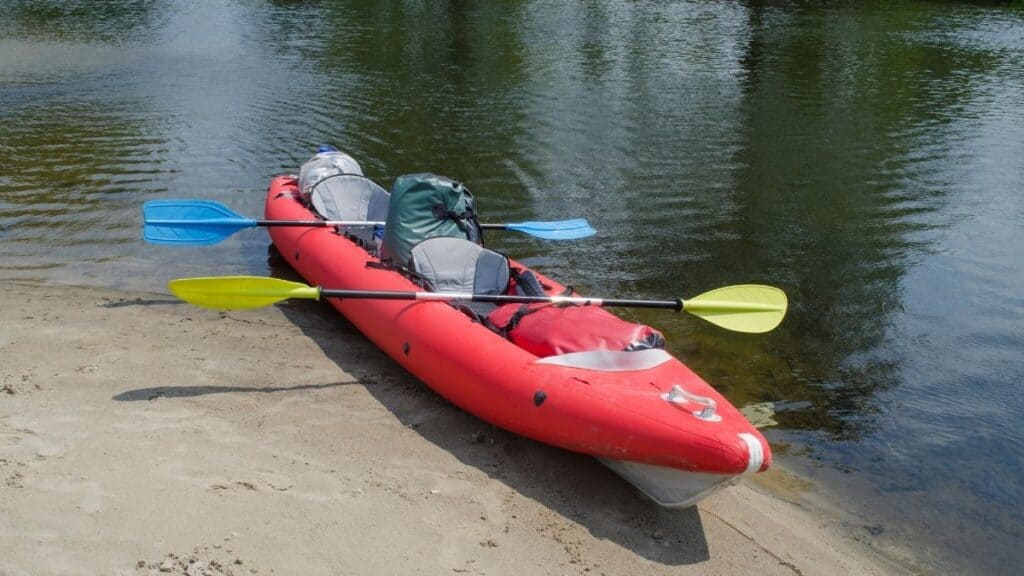
A dry bag is an important piece of gear for anyone who loves the outdoors.
Whether you’re kayaking, rafting, fishing, or just out enjoying a day at the beach, a dry bag can keep your belongings safe and dry.
What is a Dry Bag?
A dry bag is a waterproof bag used to keep belongings safe and dry. Dry bags come in all shapes and sizes, but they all have one common goal: keeping your gear dry.
Table of Contents
How Does a Dry Bag Work?
A dry bag works by using a closure system that is airtight and watertight. This closure system can vary depending on the type of bag but often includes either a zipper or a buckle system.
Dry bag designs also vary and may include a roll-top or barrel-roll design that creates an airtight seal when closed properly.
Dry bags are a great option for keeping your belongings safe and dry when participating in watersports or other activities involving water contact. With a variety of sizes and types available, there’s sure to be one perfect for your needs.
So, don’t let a little moisture spoil your fun – grab a dry bag and get out there!
What are some common uses?
Some common uses for a dry bag include kayaking, rafting, fishing, boating, swimming, and camping.
A dry bag can also be useful for everyday activities, such as taking your laptop to the beach or carrying your lunch to work.
Are there any other benefits?
In addition to keeping your belongings safe and dry, a dry bag can also help you organize your gear.
Most dry bags have multiple pockets and compartments, which makes it easy to store everything from clothes and food to fishing tackle and camping gear.
What goes in a dry bag?
Almost anything can go in a dry bag. However, it is important to remember that the weight of the bag will be affected by the amount and type of gear you pack.
For example, if you’re kayaking, you’ll want to pack light so that you don’t overload the boat.
Can you put wet things in a dry bag?
You can put wet things in a dry bag, but it is important to remember that the weight of the bag will be affected by the amount and type of gear you pack.
For example, if you’re kayaking, you’ll want to pack light so that you don’t overload the boat.
Here are a few tips for using a dry bag:
- Make sure that the seal is closed properly before use
- If possible, try to keep the bag as empty as possible. This will help reduce the weight and make it easier to carry
- Pack your belongings tightly so that they don’t move around inside the bag.
- Remember that not everything needs to go in a dry bag. Only pack the items that you need

Types of Dry Bags
There are many different types of dry bags available on the market, each with its own set of advantages and disadvantages. Here is a brief overview of some of the most common types:
1. Barrel Roll Top Dry Bags
Barrel roll-top dry bags are perhaps the most frequent type of dry bag. They are cylinder-shaped with one end open. To make these dry bags airtight, the seams are usually bonded with RF welding.
The gear is put into the bag through the open end. Normally, the open end is closed by rolling down the excess cloth at the top and securing two clips together. In most cases, this type of sealing is watertight.
It should be able to endure rain and waves, and if placed in water, it should produce an airtight seal that allows the dry bag to float for an extended amount of time.
2. Dry Bag Holdalls
Dry bag holdalls often have a larger aperture than Roll top barrel bags. This makes it easier to reach the contents than a barrel bag.
In general, the closure of a holdall bag is less waterproof than that of a barrel bag because it is more difficult to keep pressure on the rolled-down material.
In most cases, the bags are still impermeable, and the change is only noticeable in total immersion scenarios.
3. Rucksack Dry Bags
Rucksack dry bags are the perfect option for hikers and backpackers. They have various carrying straps that make it easy to transport them on your back.
The bag is then sealed by rolling down the top and securing two clips together. This type of closure is not as watertight as the barrel roll top, but it is more secure than a holdall.
4. Duffel Bag Dry Bags
Duffel bag dry bags are designed like traditional duffel bags, with one large compartment and no internal dividers.
The opening is closed using a waterproof zipper, making these bags less airtight than other dry bags.
However, they are still an excellent option for everyday use because they are spacious and durable.
5. Kayak Dry bags
Kayak dry bags are designed specifically for use in extreme weather conditions.
They have a cylindrical shape and are made from waterproof materials that can withstand the abuse of rapids and waves.
Some kayak dry bags come with backpack straps, making them easy to transport.
6. Waterproof Phone Cases
If you’re looking for a small and lightweight option, consider investing in a waterproof phone case. These cases are designed to protect your phone from water damage, and many models also offer protection from sand and dust.
Most cases feature a clear front so that you can still use your phone while it’s protected.
7. Motorcycle Dry Bags
Motorcycling can be just as wet as many watersports, with rain pelting against you as you go at speeds of up to 70 miles per hour. To say the least, keeping your stuff dry in these conditions is difficult!
This is where a motorcycle dry bag comes in handy. These bags are specially designed to keep your belongings completely safe and dry, even in the worst weather conditions.
They typically have a roll-top closure and are made from heavy-duty materials that can withstand abrasion.

Are Drybags Waterproof?
The short answer is yes, dry bags are waterproof. However, there are a few things to remember to ensure your belongings remain dry.
- First, ensure your bag’s closure is secure before entering the water.
- Second, avoid packing items that will create moisture inside the bag (such as food).
- Finally, always test the bag in a low-risk environment before taking it into more extreme conditions.
Also, it depends on what the term waterproof means to you!
Did you know that there are standardized systems used to describe an object’s waterproof ability?
The IP Code, or Ingress Protection Rating, is a system used to rate the degree of protection that an object has against solid objects and liquids. The rating consists of two numbers (the first referring to solids and the second referring to liquids), with each number ranging from 0-XX. An example of an IP code would be something like IP67, which would mean that the object has complete protection against dust and can withstand immersion in water up to one meter deep for up to 30 minutes.
Given the description, dry bags can be further classified into three categories:
- Splashproof
- Water-resistant
- Submergible dry bags
Splashproof dry bags are designed to protect your belongings from light rain and splashes but are not effective in keeping water out in heavier downpours or extended submersion.
On the other hand, water-resistant dry bags can withstand more prolonged exposure to moisture but are not completely waterproof.
Finally, submergible dry bags can be submerged in water for extended periods, keeping all contents inside completely protected.
How to Test If Bag Will Leak
The easiest way to test if a dry bag will leak is to fill it with water and seal the closure.
If the bag does not leak, you can be confident that it will keep your belongings safe and dry in any weather condition.
However, if the bag leaks, try adjusting the closure until you find a configuration that prevents water from entering.
What Type of Dry Bag Is Best for Me?
Now that you know a little more about dry bags, it’s time to choose the right one for you. Here are a few things to keep in mind when making your selection:
Purpose
What will you be using the dry bag for? Activities such as kayaking, motorcycling, and rafting require different types of protection than everyday use.
Size
How much stuff do you need to store? Dry bags come in a variety of sizes, so choose one that’s right for your needs.
Material
Consider the environment in which you’ll be using the bag and choose a material that will meet the conditions.
For example, if you’ll be kayaking in salt water, a bag made from PVC or vinyl may not be the best option.
Closure type
Dry bags come with a variety of closure types, so choose the one that fits your needs.
Roll-top closures are typically more waterproof than zippers, but some bags come with both options.
Why is a dry bag better than a freezer bag?
Freezer bags are not designed to be waterproof, and they will not keep your belongings safe in wet or snowy conditions.
In contrast, a quality dry bag is made from heavy-duty materials that can withstand abrasion and is specifically designed to keep water out.
Also, freezer bags do not typically have a roll-top closure, making them less effective at preventing water from entering.
Are dry bags really necessary?
Dry bags are not necessary for every activity, but they can be a lifesaver in certain situations.
For example, if you’re going kayaking and don’t want to risk losing your phone or camera to the water, a dry bag is a must-have piece of gear!
They’re also great for keeping your clothes and food dry during camping trips and other outdoor adventures!
Overall, dry bags are a must-have for any outdoor enthusiast, and they come in a variety of sizes to suit your needs. Whether you’re kayaking down the rapids or hiking in the rain, a dry bag will keep your belongings safe and dry.
So next time you hit the great outdoors, be sure to bring one along!
How do dry bags work?
Dry bags are specially designed bags that are used to keep the contents inside protected from water, moisture, and other environmental elements.
They work based on a few key features:
- Waterproof Material: Dry bags are typically made from waterproof or water-resistant materials such as nylon, PVC, or TPU (thermoplastic polyurethane). These materials create a barrier that prevents water from entering the bag and reaching the items inside.
- Roll-Top Closure: The opening of a dry bag is usually designed with a roll-top closure system. This involves rolling the opening of the bag several times and securing it with a buckle or snap closure. This creates a watertight seal, preventing water from seeping in through the top of the bag.
- Watertight Seams: Dry bags often have seams that are either welded or taped to enhance their waterproofing capabilities. These seams are either heat-sealed or bonded with waterproof tape, ensuring water cannot penetrate the stitched areas.
When using a dry bag, you typically place your items inside the bag, ensuring they are properly sealed and protected.
Once the items are inside, you roll down the top of the bag several times, creating a tight seal, and secure it with the buckle or snap closure. This seals the bag and prevents water from entering.
It’s important to note that while dry bags provide high water resistance, they may not be completely waterproof in all circumstances, especially if submerged for extended periods or subjected to excessive pressure.
Following the manufacturer’s instructions and testing the bag’s waterproofing capabilities is always recommended before relying on it in extreme conditions.
